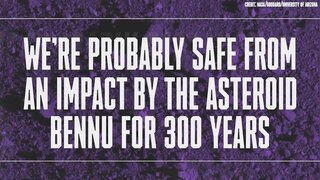Create a free profile to get unlimited access to exclusive videos, sweepstakes, and more!
NASA Reveals First Details of OSIRIS-REx Asteroid Sample
With extra bonus asteroid dirt!
SYFY’s The Ark (streaming now on Peacock) takes human exploration of space a century into the future, when humans are venturing beyond our own solar system to colonize distant worlds. In the real world, we still have plenty to learn closer to home and getting astronauts even to our own Moon remains a herculean task.
Our solar system is filled with planets, moons, asteroids, and other celestial leftovers, all of which contain vast stores of information about the nature of reality. Usually, we have to look at them from a distance using our telescopes, but recently scientists built a machine to catch up with an asteroid, snag of a piece of that asteroid, and bring it back home.
Scientists Get First Look at Asteroid Bennu Return Sample
NASA’s OSIRIS-REx mission launched September 8, 2016, and spent years first traveling to Bennu and then orbiting around it. During its time circling the asteroid, OSIRIS-REx took a boat load of pictures, mapped the asteroid’s surface, and searched for a good place to touch down.
RELATED: NASA's First Ever Asteroid Sample Return Mission Successfully Lands in Utah
In a harrowing feat of engineering the craft carefully descended to the surface of Bennu, scooped up a handful of its surface material, and lifted itself back into space. With its treasure in hand, OSIRIS-REx then turned its tail and rocketed back toward the Earth on a flyby delivery run. The asteroid sample cannister landed September 24, in Utah’s West Desert before being transported to Johnson Space Center (JSC) in Houston.
Since then, scientists have been busy carefully making their way into the sample cannister to the goodies inside. Getting eyes and gloved hands on the sample is a complicated process involving a bespoke clean room designed specifically for this work. Turns out, Bennu left us a little surprise in the form of extra material. When scientists opened the first part of the cannister, they found extra asteroid material covering the collector head, canister lid, and base.
“The OSIRIS-REx sample is the biggest carbon-rich asteroid sample ever delivered to Earth and will help scientists investigate the origins of life on our own planet for generations to come,” said NASA Administrator Bill Nelson, in a statement. “Almost everything we do at NASA seeks to answer questions about who we are and where we come from. NASA missions like OSIRIS-REx will improve our understanding of asteroids that could threaten Earth while giving us a glimpse into what lies beyond. The sample has made it back to Earth, but there is still so much science to come – science like we’ve never seen before.”
RELATED: Everything You Need to Know About NASA's "Asteroid Autumn"
Preliminary analysis of that excess space dirt using a scanning electron microscope, infrared measurements, X-ray diffraction, and chemical element analysis revealed evidence of high carbon content and water, suggesting that Bennu and asteroids like it carry the building blocks of life. Those results, however, are just the beginning of what Bennu likely has in store for us.
Over the next several years, scientists at JSC and around the world will study the sample in hopes of unlocking the secrets of the formation of the solar system.
In the meantime, catch up on the complete first season of The Ark, streaming now on Peacock!




































